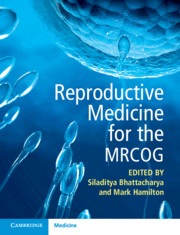Book contents
- Reproductive Medicine for the MRCOG
- Reproductive Medicine for the MRCOG
- Copyright page
- Contents
- Contributors
- Chapter 1 Epidemiology and Initial Assessment of the Infertile Patient
- Chapter 2 Disorders of Ovulation and Reproductive Endocrine Disorders Associated with Infertility
- Chapter 3 Endometriosis
- Chapter 4 Uterine and Tubal Causes of Infertility
- Chapter 5 Andrology and Infertility
- Chapter 6 Unexplained Infertility
- Chapter 7 Assisted Reproduction
- Chapter 8 Adjuvants in Assisted Reproduction
- Chapter 9 Laboratory Procedures for Assisted Reproduction
- Chapter 10 Fertility Preservation
- Chapter 11 Third-Party Reproduction
- Chapter 12 Managing Ethical Dilemmas in Reproductive Medicine
- Chapter 13 Evidence-Based Reproductive Medicine
- Chapter 14 The Organisation of Services and Quality Assurance in Fertility Practice
- Index
- References
Chapter 9 - Laboratory Procedures for Assisted Reproduction
Published online by Cambridge University Press: 25 February 2021
- Reproductive Medicine for the MRCOG
- Reproductive Medicine for the MRCOG
- Copyright page
- Contents
- Contributors
- Chapter 1 Epidemiology and Initial Assessment of the Infertile Patient
- Chapter 2 Disorders of Ovulation and Reproductive Endocrine Disorders Associated with Infertility
- Chapter 3 Endometriosis
- Chapter 4 Uterine and Tubal Causes of Infertility
- Chapter 5 Andrology and Infertility
- Chapter 6 Unexplained Infertility
- Chapter 7 Assisted Reproduction
- Chapter 8 Adjuvants in Assisted Reproduction
- Chapter 9 Laboratory Procedures for Assisted Reproduction
- Chapter 10 Fertility Preservation
- Chapter 11 Third-Party Reproduction
- Chapter 12 Managing Ethical Dilemmas in Reproductive Medicine
- Chapter 13 Evidence-Based Reproductive Medicine
- Chapter 14 The Organisation of Services and Quality Assurance in Fertility Practice
- Index
- References
Summary
Successful assisted reproduction treatment is critically dependent on consistent laboratory performance. Each laboratory process, from collection of oocytes and preparation of sperm for use in fertilisation in vitro, through embryo culture, assessment, selection for transfer, biopsy for genetic testing, to the storage (cryopreservation) of gametes and embryos for use in later treatment, carries an inherent risk of damage, whether mechanical or through exposure to suboptimal conditions outside the body, with consequences for the chance of successful clinical outcome. Training, competency in specific, unique technical skills and consistent performance of all laboratory practitioners are vital in the ART laboratory. Procedures must be carried out meticulously, adhering to standard operating procedures, with precise attention to detail. Strict adherence to guidelines issued by regulatory and professional bodies is necessary and essential in order to minimise risk and maximise performance. The implementation of a Quality Management System ensures consistent, optimised performance, and facilitates risk assessment and root cause analyses.
Keywords
- Type
- Chapter
- Information
- Reproductive Medicine for the MRCOG , pp. 93 - 112Publisher: Cambridge University PressPrint publication year: 2021
References
- 1
- Cited by



